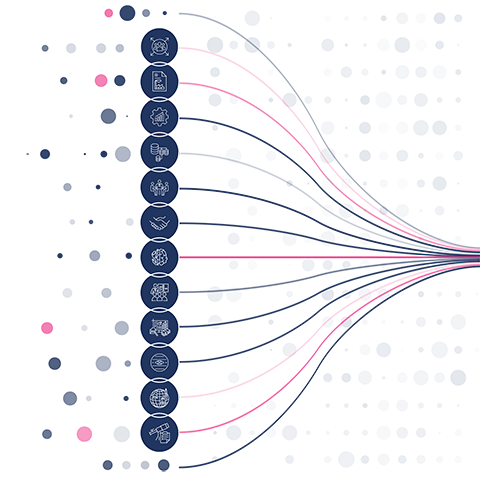
12 sales trends: Cultivating a more adaptable and integrated sales organization
These 12 sales trends serve as a roadmap for sales leaders looking to cultivate a more adaptable and integrated organization that evolves with today’s sophisticated buyers.
The sales organization is now laser-focused on targeting a hybridized, multichannel buyer in a digital-first, buyer-centric market. This shift in focus is not only here to stay; it is also bound to evolve due to drivers such as technology, macroeconomics, and workplace culture.
Below are 12 trends that demonstrate how the sales organization is evolving to be more adaptable and integrated. If these trends represent the direction in which the sales organization is headed, the vehicle that will get them from point A to point B is sales performance management.
1. Upskilling to build hybrid relationships
Although the pandemic forced sales teams to engage more in hybrid selling – the new normal of catering to customers’ buying preferences through a mix of remote, e-commerce, and other channels – their most important goal remains building relationships with customers. Before the COVID-19 pandemic, sales teams traditionally met with prospective customers in person at their workplaces, allowing them to read body language, gauge level of interest, and connect with stakeholders. However, in a virtual meeting, sales teams may only meet with a single customer contact after spending more time, effort, and resources to get their attention, make a connection, and form a relationship. This new setting provides an upskilling opportunity for sales teams so they can perform in an environment they were largely unprepared for.
2. Learning B2C practices
By 2025, it’s expected that 80% of B2B sales interactions between suppliers and buyers will take place digitally, according to Gartner’s Future of Sales 2025 report.1 At the same time, top sales innovators are embracing and reimagining how they can use data and technology across their organizations to reach newer heights.2 B2C selling, also known as direct selling, acclimated to a digital or omnichannel sales environment far before B2B selling, so the creativity in using new tools, technologies, and channels to engage and nurture customers are tactics that B2B teams can learn and emulate.
3. Capturing value from data
Organizations have a wealth of information at their fingertips, but making sense of it and using it to advance their sales activities and processes are still works in progress. That being said, more organizations are employing sophisticated analytics to make historical data more predictive and are therefore spotting both trends and risks, empowering teams to take meaningful action in a timely manner.
4. Differentiating through value
As customers become more educated about products and services, they are keen to understand the value those products and services can provide. Rather than differentiate by features, sales teams must pivot to focus more on the value their products and services provide, and how they help customers achieve what they didn’t know was possible. It’s important for salespeople to be in tune with their customers’ needs and provide valuable perspectives and information on how to solve their problems.
5. Sales and marketing partnership
Sales and marketing teams in high-performing organizations tend to have a tight relationship, but it is often one-sided. Both capture insightful data on customers and their preferences; however, sales teams are the predominant beneficiaries of this data. When both teams work in tandem and share information equally, they can better identify impacts at the top of the sales funnel that translate into higher-value opportunities. This visibility and collaboration can shorten sales cycles and improve the quality of the funnel.
6. Collaborating through integrated business planning
Trying to drive business decisions based on information siloes will lack depth and breadth, and unifying data manually from across the organization – supply, demand, product, and financials – is onerous and error-prone. Integrated business planning (IBP) is the next generation of decisive planning, with technology-driven, cross-functional collaboration at its core. IBP integrates information with the sales organization and streamlines the collaboration between people and technology.
7. Adopting automation and artificial intelligence (AI)
Forty percent of traditional sales tasks within an organization can now be automated – and that could rise to 50% as technology, especially natural language processing, advances, according to joint research between Salesforce and the McKinsey Global Institute.3 Meanwhile, organizations are rapidly transforming themselves digitally, making record-breaking investments in 2022, up 65% from just two years ago, according to 2022 EY-Parthenon research.4 These investments, coupled with meeting the expectations and digital nascence of younger generations of talent, amount to an evolving sales organization that is increasingly predictable, scalable, and transparent.
8. Engaging more educated buyers
Customers are increasingly conducting extensive research and entering sales funnels independently of supplier sales teams. Due to their process of self-guided discovery, customers come to the table with a more sophisticated understanding about the products and services in the market as well as the competitive landscape. Because of this trend in customer behavior, the awareness and consideration phases of the traditional sales funnel have become more difficult to measure and track: this is known as “the dark funnel.” The dark funnel is used to describe the touchpoints outside the traditional sales funnel (both online and offline) where buyers engage, research, and make decisions but aren’t immediately accounted for by attribution or tracking software.5
9. Combatting inflation with visibility
Most organizations are currently seeing inflationary pressure coming from multiple dimensions as suppliers are raising the cost of materials throughout supply and value chains. These price increases raise unsettling questions about passing along costs to customers and their tolerance for cost increases, as well as margin pressures and acceptable margins that organizations can bear. At the same time, buyers, who are also coping with inflation, are tightening their budgets and spending less on products and services. As a result, sales teams may see fewer opportunities, detrimentally impacting the pipeline. In this climate of enduring inflationary pressure, organizations must have visibility into these impacts in real time so they can identify pain points, adapt strategies, and manage operational impact sooner rather than later.
10. Cultivating equity through transparency
Sales organizations with leading diversity, equity, and inclusion (DEI) practices boast higher forecasts and conversion and customer satisfaction rates.6 As sales teams and their customers become more diverse, the days of shadow processes and institutionalized inequities wane. Organizations that aspire to be truly diverse and inclusive can only accomplish this by institutionalizing transparency and accountability as fundamental values of workplace culture. Transparency, for example, could reveal gender pay inequities in the sales organization or show favorability in allocating bigger opportunities. Sales leaders who understand the business value of DEI also understand that the ability to identify, replicate, and communicate successes is critical to growing and motivating a high-performing and increasingly diverse sales team.
11. Assessing market expansion through a geopolitical lens
Global organizations must consider geopolitics, especially as the war in Ukraine continues to rock the global economy. In this climate, countries are taking different approaches in how they’re responding and engaging on the world stage, which, in turn, is impacting organizations depending on where they’re based and where they conduct business activity.7 Sales leaders cannot overlook geopolitical tension in their risk assessment when considering new market expansion. They must evaluate the potential implications from government intervention, distinct economic blocs or alliances, trade barriers, supply chain constraints, and hiring regulations.
12. Enabling decisiveness through simplified sales forecasting
Resilient sales organizations need sales leaders who are confident in their sales forecasts and can make decisions with accuracy, precision, and speed. This confidence comes not simply from the presence of data, but from a meaningful understanding of the data and its implications. It also comes from using the same terminology and language across an organization and all its locations, resulting in a clear, consistent, and transparent interpretation of a forecast. No matter the size of data at hand, a forecast that is simplified is a forecast that will enable a culture of decisiveness and confidence in the sales organization.
Sales organizations must address what motivates today’s sophisticated buyers as technology, geopolitical events, and a hybrid work environment continue to influence the market. Those that get a full picture of their data through integration, automation, and simplified forecasting will be able to keep pace with buyers’ needs into the future.
1 Gartner, Future of Sales 2025: Why B2B Sales Needs a Digital-First Approach, Kelly Blum, 23 September 2020
2 McKinsey & Company, The domino effect: How sales leaders are reinventing go-to-market in the next normal, 1 October 2020
3 Salesforce, The 7 Biggest Trends Upending Sales Today
4 EY, The CEO Imperative: How to remain resolute on investment as inflation surges, 4 October 2022
5 Predictable Profits, What is the Dark Funnel (And What Does it Have to Do With My Marketing Strategy)?
6 Forrester, Diversity Drives Sales Success, November 2021
7 EY, The CEO Imperative: Prepare now for the new era of globalization, 8 September 2022





